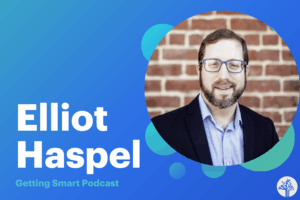How Project-Based Learning Prepares Youth for Freelance Nation

It’s been a decade since I had a job–that employment bargain where you get paid a specified amount for completing regularly assigned duties. Over that same period of time I’ve led or contributed to hundreds of projects– thousands if you include blogs as short projects.
This sort of project-based life is no longer unusual. About a third of American workers now engaged in some kind of freelancing work (here’s a list of 150 types). Freelance work includes gigs and projects:
- Gigs are short term predefined and repeatable tasks (e.g., Uber drivers, nannies, live-performance musicians).
- Projects are unique assignments with specific deliverables and timeframe (e.g., computer programmer, graphic designer).
Let’s add a skill dimension and consider career options in the freelance economy. With apologies for career choices not well represented, the following tables shows gigs (short term, low skill routine tasks) and projects (longer term, non-routine deliverables) and wage opportunities.
Career Options in the Freelance Economy
Low skill/routine |
Medium skill/rule set application |
High skill/ non-routine |
|
| Short term task | Driver | Tax prep, lawyer, financial planner | Live-performance musician, writer, specialist |
| Medium/long term deliverable | Landscaper | Engineering, video production | Designer, programmer |
Wage Opportunity in the Freelance Economy
Low skill/routine |
Medium skill/ rule set application |
High skill/ non-routine |
|
| Short term task | Low wage (some automation) | Automation | Moderate wage (some automation) |
| Medium/long term deliverable | Low wage | Moderate wage (some automation) | High wage |
These charts lead to four important observations:
- Low-skill gigs may stick around for a while but they won’t pay well, consistently.
- Short-term rule application tasks (e.g., tax prep, financial planning, legal filings, financial reporting) are quickly being replaced by automation.
- High-skill short-term tasks can be lucrative but the key is building a repeatable revenue stream (i.e., marketing).
- The most lucrative freelance category is long-term projects requiring non-routine deliverables and that requires content knowledge and project management–the same is true for fulltime employment.
Young people that decide against the freelance economy and land good jobs with organizations are likely to do most of their work in projects. Other than low skill/low wage tasks, it’s quickly becoming a project-based world.
Just-in-time Learning. Not surprisingly Dennis Yang, president of the biggest just-in-time (JIT) online learning marketplace Udemy (where I’m an investor), thinks this shift to freelancing is a big deal. Yang sees the need for freelancers to learn and upskill in a fluid work environment:
“As more companies choose to depend on contract workers for key parts of their business, those freelancers will see increasing competition for those gigs and, therefore, more pressure to differentiate themselves and their skills.”
Examples of JIT learning resources include Seth Godin’s freelancer course and lots of Udemy project management and home business courses.
This shift to the freelance economy and just-in-time learning is accompanied by new market signaling strategies. It’s becoming less important where you went to school and more important what you can do to add value.
Last year, accounting firms Ernst & Young and Deloitte announced changes to the way they assess job candidate readiness, such as a “school-blind” hiring process. Instead, they’ll use their own measures of knowledge and skill.
“Educational pedigree increasingly takes a backseat to skills-based assessments and employers [will] look to reduce the noise and bias associated with traditional education signals,” said Yang, “In doing so, employers will gather a clearer picture of what applicants are really capable of, not just what they say they’ve studied or can discuss in abstract.”
“Listing degrees on a resume is out,” suggests Yang, “Successfully completing projects that demonstrate competencies is in.” That’s why it’s becoming increasingly important for students and graduates to curate a collection of personal bests to show what they know through what they’ve done.
Career prep. Given the new realities of a project-based world, Scott McLeod asks the big question:
Are most schools helping students learn how to leverage their individual interests and skill sets to ‘out-innovate their peers’ and differentiate themselves from the crowd? Are most schools helping students learn how to adopt entrepreneurial mindsets, workflows, and financing techniques in order to be both self-sufficient and competitive in a highly-complex, rapidly-shifting work landscape? Are most schools teaching students how to ‘learn and upskill’ themselves so that they optimize their chances to be selected for the next gig that they’re seeking?
The answer is obviously no. McLeod said we’re still “running students through a ‘one size fits all’ model, assessing students in standardized ways, discounting students’ unique strengths and talents, and completely ignoring the economic and workforce realities into which they’re sending their supposedly-qualified graduates.”
What kinds of experiences would prepare young people for a project-based world? Here are six tips:
- Real work. Give students real world work like internships at Big Picture, integrated projects at New Tech Network, applied work at NAF career academies, and real customers at NYC iSchool.
- Interest. Some work should be interest-based and self-directed where students have the ability to define the topic and the deliverable. A teacher (and project-based tools) can help incorporate standards into the project plan and rubric assessment.
- Petsonalized. Companies like Google provide JIT learning modules for new team leaders. Similarly, New Tech Network and Summit Public Schools provide just-in-time personalized learning to prepare students to engage in complex projects.
- Feedback. Learners deserve real time feedback not just a graded deliverable. Ron Berger, EL Education, says, “If the teacher isn’t assessing all along the way then the final product will not typically show the high quality of success.”
- Public. Buck Institute notes that making a final deliverable a “Public Product” is what most differentiates PBL from traditional instruction. The film Most Likely to Succeed, highlights High Tech High students preparing for their presentation of learning–a high stakes assessment but one that is authentic, student-shaped, and public.
- Explicit. Students should not only learn through projects, they should learn about project management and team leadership. Student should graduate from high school with a “black belt” in project management and portfolio of evidence.
We’d love to hear from you if you have good examples of preparing young people for a project-based world.
For more see:
- 3 Tips to Support Project-based Learning for Low-Income Students
- Schools for Wisdom: Personalized Project-Based Learning
Stay in-the-know with all things EdTech and innovations in learning by signing up to receive the weekly Smart Update. This post includes mentions of a Getting Smart partner. For a full list of partners, affiliate organizations and all other disclosures please see our Partner page.






0 Comments
Leave a Comment
Your email address will not be published. All fields are required.